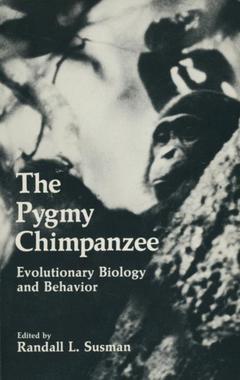Description
The Pygmy Chimpanzee, Softcover reprint of the original 1st ed. 1984
Evolutionary Biology and Behavior
Evolutionary Biology Series
Language: English
Subjects for The Pygmy Chimpanzee:
Publication date: 05-2012
464 p. · Paperback
464 p. · Paperback
Description
/li>Contents
/li>
Historical Remarks Bearing on the Discovery of Pan paniscus Whether by accident or by design, it was most fortunate that Robert M. Yerkes, the dean of American primatologists, should have been the first scientist to describe the characteristics of a pygmy chimpanzee, which he acquired in August 1923, when he purchased him and a young female companion from a dealer in New York. The chimpanzees came from somewhere in the eastern region of the Belgian Congo and Yerkes esti mated the male's age at about 4 years. He called this young male Prince Chim (and named his female, com mon chimpanzee counterpart Panzee) (Fig. I). In his popular book, Almost Human, Yerkes (1925) states that in all his experiences as a student of animal behavior, "I have never met an animal the equal of this young chimp . . . in approach to physical perfection, alertness, adaptability, and agreeableness of disposition" (Yerkes, 1925, p. 244). Moreover, It would not be easy to find two infants more markedly different in bodily traits, temperament, intelligence, vocalization and their varied expressions in action, than Chim and Panzee. Here are just a few points of contrast. His eyes were black and in his dark face lacked contrast and seemed beady, cold, expressionless. Hers were brown, soft, and full of emotional value, chiefly because of their color and the contrast with her light complexion.
I. Molecular Biology, Systematics, and Morphology.- 1 The Tervuren Museum and the Pygmy Chimpanzee.- 2 Blood Groups of Pygmy and Common Chimpanzees: A Comparative Study.- 3 Pygmy Chimpanzee Systematics: A Molecular Perspective.- 4 A Measure of Basicranial Flexion in Pan paniscus, the Pygmy Chimpanzee.- 5 The Dentition of the Pygmy Chimpanzee, Pan paniscus.- 6 An Allometric Perspective on the Morphological and Evolutionary Relationships between Pygmy (Pan paniscus) and Common (Pan troglodytes) Chimpanzees.- 7 Body Size and Skeletal Allometry in African Apes.- 8 Body Build and Tissue Composition in Pan paniscus and Pan troglodytes, with Comparisons to Other Hominoids.- 9 The Common Ancestor: A Study of the Postcranium of Pan paniscus, Australopithecus, and Other Hominoids.- II. Behavior of Pan paniscus.- 10 Feeding Ecology of the Pygmy Chimpanzees (Pan paniscus) of Wamba.- 11 Feeding Ecology of Pan paniscus in the Lomako Forest, Zaire.- 12 Interaction over Food among Pygmy Chimpanzees.- 13 Social Organization of Pan paniscus in the Lomako Forest, Zaire.- 14 Sexual Behavior of Pan paniscus under Natural Conditions in the Lomako Forest, Equateur, Zaire.- 15 The Locomotor Behavior of Pan paniscus in the Lomako Forest.- 16 Pan paniscus and Pan troglodytes: Contrasts in Preverbal Communicative Competence.- 17 Will the Pygmy Chimpanzee Be Threatened with Extinction as Are the Elephant and the White Rhinoceros in Zaire?.- Author Index.
© 2024 LAVOISIER S.A.S.




